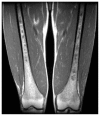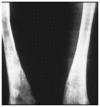Clinical manifestations and management of Gaucher disease
- PMID: 26604942
- PMCID: PMC4625773
- DOI: 10.11138/ccmbm/2015.12.2.157
Clinical manifestations and management of Gaucher disease
Abstract
Gaucher disease is a rare multi-systemic metabolic disorder caused by the inherited deficiency of the lysosomal enzyme β-glucocerebrosidase, which leads to the accumulation of its normal substrate, glucocerebroside, in tissue macrophages with damage to haematological, visceral and bone systems. Anaemia, thrombocytopenia, enlargement of liver and/or spleen, skeletal abnormalities (osteopenia, lytic lesions, pathological fractures, chronic bone pain, bone crisis, bone infarcts, osteonecrosis and skeletal deformities) are typical manifestations of the most prevalent form of the disease, the so-called non-neuronopathic type 1. However, severity and coexistence of different symptoms are highly variable. The determination of deficient β-glucocerebrosidase activity in leukocytes or fibroblasts by enzymatic assay is the gold standard for the diagnosis of Gaucher disease. Comprehensive and reproducible evaluation and monitoring of all clinically relevant aspects are fundamental for the effective management of Gaucher disease patients. Enzyme replacement therapy has been shown to be effective in reducing glucocerebroside storage burden and diminishing the deleterious effects caused by its accumulation. Tailored treatment plan for each patient should be directed to symptom relief, general improvement of quality of life, and prevention of irreversible damage.
Keywords: Gaucher disease; activated macrophage; enzyme replacement therapy; glucocerebroside; storage burden.
Figures
References
-
- Grabowski GA, Petsko GA, Kolodny EH. In The Online Metabolic and Molecular Bases of Inherited Disease (wwwomm-bidcom) New York: McGraw-Hill; 2006. Gaucher disease. (revised July 2010)
-
- Cox TM. Gaucher disease: understanding the molecular pathogenesis of sphingolipidoses. J Inherit Metab Dis. 2001;24(Suppl 2):106–121. - PubMed
-
- Barak V, Acker M, Nisman B, et al. Cytokines in Gaucher’s disease. Eur Cytokine Netw. 1999;10(2):205–210. - PubMed
Publication types
LinkOut - more resources
Full Text Sources
Other Literature Sources


